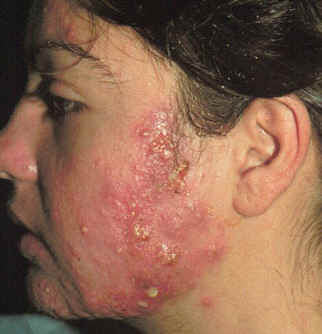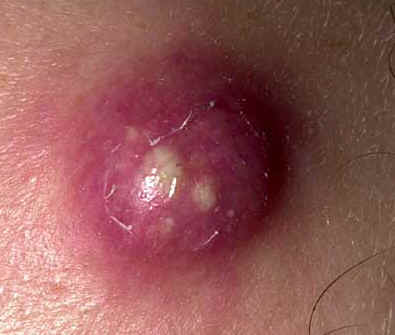Staphylococcus infections
Introduction
Staphylococcus is an opportunistic pathogen that can cause infections through
broken skin or when introduced into the body via a catheter or other device.
Most Staph infections are skin and surface infections that vary in their
presentation depending on the depth and extent of infection. These include
impetigo, folliculitis, carbuncles, furuncles and wound infections. Systemic
infections (bacteremia, endocarditis, and pneumonia) as well as toxic shock
syndrome and food poisoning also occur. Staphylococcus infections cause tissue
and cell damage through production of certain virulence factors (e.g.
hylaronidase) and exotoxins such as TSST-1.
Staphylococcus aureus
- Cause: Staphylococcus aureus
- Microscopy: Gram-positive clusters
- Diagnosis: Selective media such as Mannitol Salt Agar; coagulase;
DNAse
Staphylococcal Scalded Skin Syndrome
- Symptoms: Redness and inflammation around the mouth, spreading to
entire skin surface. Any pressure causes skin to blister and come loose.
Entire epithelium can come loose and is replaced after 7-10 days
- Complications: Secondary infections in denuded skin
- Pathogenesis: Exotoxins (ETA, ETB) break desmosomes between cells
in epidermis
- Treatment: Supportive/prevent infection
Toxic Shock Syndrome
- Symptoms: fever, hypotension, diffuse reddening rash, skin
exfoliation
- Complications: Multiple organ system damage, shock leading to death
- Pathogenesis: Local production of TSS-1, particularly in
environment of hyperabsorbent tampons. TSS-1 stimulates cytokine release,
inflammation, endothelial fluid leakage
- Treatment: Antibiotics to prevent recurrence
Cutaneous infections:
The production of virulence factors such as lipase and hyaluronidase
increases the spread and severity of the infection, especially important in
furuncles and carbuncles
- Impetigo: Superficial infection on face and limbs. Small pus-filled
vecicle on a red area; eventually crusts over
- Folliculitis: Pus-filled infection of hair follicle
- Furuncles (boils): Extended folliculitis; large painful nodules
with dead tissue; may need to be drained
-
- Carbuncles: Multiple furuncles joined; surface drainage, deeper
infection, bacteremia leading to fever and chills
- Wound infections: Pus, pain, edema, redness




Systemic Staphylococcus infections
- Endocarditis: 50% mortality
- Pneumonia: abscesses
- Osteomyleitis/arthritis: may start with skin infection
Coagulase-negative Staphylococcus
- Endocarditis, esp. of artificial valves
- catheter & shunt infections
- Prosthetic joints
- Urinary tract infections






